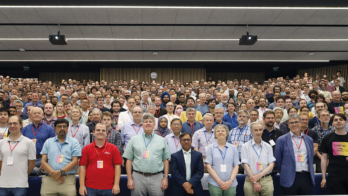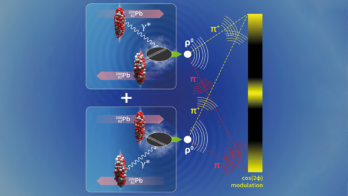New ideas for radioactive beam experiments, ranging from nuclear physics to low-temperature physics and supernovae, were on the agenda at a CERN workshop in March. Juha Äystö reports.
Scientific achievements at CERN’s ISOLDE radioactive beam facility, following its move to the laboratory’s PS booster in 1992, were the subject of a weekend meeting at CERN in March. About 100 physicists from around the world discussed the range of ISOLDE research, from exotic nuclei far from stability to nuclear astrophysics, and from fundamental symmetries to solid-state physics and biomedical applications.
The opening presentations covered the technology of radioactive beam production. Orsay’s Michel de Saint Simon and Helge Ravn of CERN each reviewed a high-resolution isotope separator designed to provide good isobar separation and consequently contaminant-free beams of proton-rich or neutron-rich isotopes for experiments starting this year. Jyväskylä’s Arto Nieminen then explained how the cooling and bunching of low energy radioactive ion beams has been achieved using gas-filled radiofrequency quadrupoles, both at ISOLDE and at his home university. This offers a new way of improving beam quality for future experiments.
REX-ISOLDE
One of the most exciting new developments for the near future is REX-ISOLDE, a post-accelerator for the ISOLDE facility that will accelerate radioactive ions up to 2.2 MeV/nucleon. Dieter Habs of Munich, spokesperson of the first experiment at REX-ISOLDE, presented the physics outlook. REX-ISOLDE’s most novel and challenging aspect is “charge breeding”. This is achieved in two stages: the required isobars are separated and bunched in a Penning trap (REXTRAP), before being ejected into an electron-beam ion source (EBIS) for charge-state breeding. The first tests at REXTRAP and EBIS have already demonstrated the expected performance with more than 20% transmission and excellent overall stability. Commissioning experiments are scheduled to begin in the autumn of this year.
Theoretical aspects
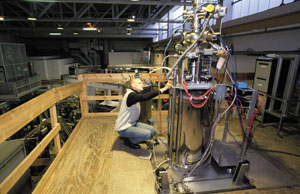
The technical aspects having been concluded, the workshop then moved on to research topics, with theoretical overviews from Alfredo Poves of Madrid and Paul-Gerhard Reinhard of Erlangen. Among the topics for investigation are core nuclear physics issues such as neutron halo systems whereby a nucleus consists of a central core with one or more loosely bound neutrons orbiting, and mapping the so-called neutron dripline of neutron rich nuclei at the limit of stability. In astrophysics, for example, ISOLDE’s potential in elucidating the rapid neutron capture (r-process) and rapid proton capture (rp-process) paths of nucleosynthesis was emphasized.
Turning to experimental nuclear structure, Karsten Riisager of Aarhus summarized the current understanding of neutron halos, where many experiments on neutron-rich lithium and beryllium ions at ISOLDE have contributed significantly. He also outlined future opportunities at REX-ISOLDE for looking beyond the driplines using low energy nuclear reactions, extending work already done at ISOLDE. On the proton-rich side of the valley of stability, experiments employing beta-delayed multiparticle decays have probed highly unbound states of light nuclei. On the neutron-rich side, recent decay studies of very neutron-rich sodium and aluminium isotopes, reported by Jyväskylä’s Saara Nummela, have resulted in new evidence for shell inversion at N = 21 and suggested the disappearance of the “magicity” of the neutron number N = 20, which was known for a long time as a good magic number in the valley of stability. This reordering of the nuclear shell structure is believed to result from the strong modification of effective nucleon interactions in nuclei very far from the valley of stability.
The physics of ground-state properties of exotic nuclei was also the subject of much attention. Munich’s Georg Bollen reported on recent progress on mass measurements by the ISOLTRAP and MISTRAL experiments, where a new era in high precision is dawning. Frank Herfurth of CERN described new data on the mass of the short lived argon-33 isotope with a precision of 10-7, exceeding all previous measurements. Rainer Neugart of Mainz gave an extensive review of a highly successful ISOLDE programme investigating ground-state properties of nuclei obtained by optical laser spectroscopy. He cited as an example a recent experiment that has provided information on moments and charge radii of neon isotopes from the proton-halo nucleus neon-17 up to the highly neutron-rich neon-28.

Nathal Severijns of Leuven gave a lively presentation covering fundamental physics beyond the Standard Model. After discussing ongoing work at the low-temperature nuclear orientation facility at ISOLDE (NICOLE), which allows the angular dependence of radioactive decay to be measured, he turned his attention to future opportunities for studying scalar contributions in the weak interaction by employing a special ion trap measuring technique that is under development at Leuven and ISOLDE.
Solid-state physics at ISOLDE was reviewed by Manfred Deicher of Konstanz. Experiments at ISOLDE can be classified into three groups: those exploiting the emission angle of radiation from implanted radioactive isotopes; hyperfine interaction spectroscopy; and labelling with radioactive isotopes. One advantage of the emission channeling method is that suitable isotopes of nearly all chemical elements exist. This has already proved useful for a large number of semiconductors. Information on the lattice sites of copper and erbium in silicon, for example, have been measured, providing a view into their structural and dynamical properties. High Tcsuperconductors of the mercury family have also been investigated with a hyperfine spectroscopy technique. The oxygen content in the charge reservoir layer was found to determine the critical temperature.
Isotopes aid identification
In the 1990s the availability of many different radioactive isotopes as pure ion beams at ISOLDE triggered a new era involving methods used for investigating optical and electronic properties of solids, especially in the field of semiconductor physics. Extremely sensitive spectroscopic techniques, like deep level transient spectroscopy, photoluminescence and the Hall effect, gain a new quality by using radioactive isotopes: owing to their decay, the chemical origin of an observed electronic and optical behavior of a specific defect or dopant can be identified unambiguously. Solid-state physicists are now looking forward to the implantation of their probes deeper into the crystals with the help of REX-ISOLDE. This will open up new possibilities for studying certain materials in greater depth than before, and of adding new materials such as ferroelectrics to ISOLDE’s repertoire.
This workshop revealed a rich spectrum of science at CERN’s veteran nuclear physics facility. New ideas in combination with ongoing effort in target and ion-source development promise a rich future for ISOLDE.



